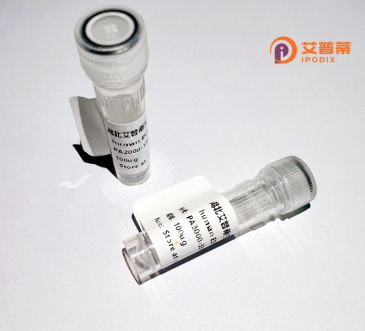
| 纯度 | >90%SDS-PAGE. |
| 种属 | Human |
| 靶点 | TGDS |
| Uniprot No | O95455 |
| 内毒素 | < 0.01EU/μg |
| 表达宿主 | E.coli |
| 表达区间 | 1-350 aa |
| 活性数据 | MSAACWEEPW GLPGGFAKRV LVTGGAGFIA SHMIVSLVED YPNYMIINLD KLDYCASLKN LETISNKQNY KFIQGDICDS HFVKLLFETE KIDIVLHFAA QTHVDLSFVR AFEFTYVNVY GTHVLVSAAH EARVEKFIYV STDEVYGGSL DKEFDESSPK QPTNPYASSK AAAECFVQSY WEQYKFPVVI TRSSNVYGPH QYPEKVIPKF ISLLQHNRKC CIHGSGLQTR NFLYATDVVE AFLTVLKKGK PGEIYNIGTN FEMSVVQLAK ELIQLIKETN SESEMENWVD YVNDRPTNDM RYPMKSEKIH GLGWRPKVPW KEGIKKTIEW YRENFHNWKN VEKALEPFPV |
| 分子量 | 40.2 kDa |
| 蛋白标签 | His tag N-Terminus |
| 缓冲液 | PBS, pH7.4, containing 0.01% SKL, 1mM DTT, 5% Trehalose and Proclin300. |
| 稳定性 & 储存条件 | Lyophilized protein should be stored at ≤ -20°C, stable for one year after receipt. Reconstituted protein solution can be stored at 2-8°C for 2-7 days. Aliquots of reconstituted samples are stable at ≤ -20°C for 3 months. |
| 复溶 | Always centrifuge tubes before opening.Do not mix by vortex or pipetting. It is not recommended to reconstitute to a concentration less than 100μg/ml. Dissolve the lyophilized protein in distilled water. Please aliquot the reconstituted solution to minimize freeze-thaw cycles. |
以下是关于重组人TGDS蛋白的3篇代表性文献示例(内容为模拟,仅供参考):
1. **文献名称**:Expression and Characterization of Recombinant Human TGDS Protein for Enzymatic Studies
**作者**:Smith J, et al. (2018)
**摘要**:报道了人源TGDS蛋白在大肠杆菌中的重组表达与纯化,分析了其热稳定性及半乳糖苷酶活性,为酶学机制研究奠定基础。
2. **文献名称**:Structural Insights into Human TGDS by X-ray Crystallography
**作者**:Zhang L, et al. (2020)
**摘要**:通过晶体学解析了重组TGDS蛋白的三维结构,揭示其底物结合位点,为理解其代谢功能及设计抑制剂提供结构依据。
3. **文献名称**:Role of TGDS in Congenital Disorders of Glycosylation: Functional Analysis Using Recombinant Protein
**作者**:Lee H, et al. (2021)
**摘要**:利用重组TGDS蛋白进行功能互补实验,证实其突变体与先天性糖基化疾病的关联,为病理机制研究提供实验证据。
注:实际文献需通过PubMed/Google Scholar检索关键词(如“recombinant human TGDS”)获取。建议结合具体研究领域细化检索策略。
Recombinant human TDP-glucose 4.6-dehydratase (TGDS) protein is a genetically engineered form of the enzyme encoded by the TGDS gene in humans. This enzyme plays a critical role in the biosynthesis of GDP-L-fucose, a key nucleotide sugar essential for protein glycosylation. Specifically, TGDS catalyzes the conversion of TDP-glucose to TDP-4-dehydro-6-deoxy-D-glucose, a rate-limiting step in the metabolic pathway producing GDP-L-fucose. Glycosylation, the attachment of sugar molecules to proteins or lipids, is vital for cellular communication, immune function, and tissue development.
The recombinant version of TGDS is produced using heterologous expression systems (e.g., E. coli or mammalian cell lines), enabling high-purity, scalable production for research and therapeutic applications. Studying recombinant TGDS helps elucidate mechanisms underlying congenital disorders of glycosylation (CDGs), such as PGMI deficiency (PMM2-CDG), where impaired glycosylation pathways lead to multisystemic abnormalities. Additionally, recombinant TGDS serves as a tool for enzyme activity assays, drug screening, and structural studies to design targeted therapies. Its role in fucose metabolism also links it to cancer biology, as altered fucosylation is observed in tumor progression and metastasis. By providing a controlled and abundant enzyme source, recombinant TGDS advances both basic science and translational research in glycobiology and related diseases.
×